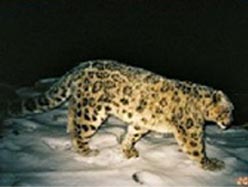
The snow leopard (
Uncia uncia) is a rare and endangered species of large feline animals. Although sharing its name with the common leopard, it is not believed to be closely related to the leopard or the other members of the Pantherine group and is classified as the sole member of its genus. Its total number in the world is generally estimated at somewhere between 3,500 to 7,000, and experts say the figure is far more outdated. Although it is believed that China is home to more snow leopards than any of the other 11 countries in which they occur, such as Afghanistan, India, Pakistan, Tajikistan, Kazakstan, Kyrgyzstan and Mongolia, no one knows exactly how many of them are there in this country.
With an objective to contribute to increasing snow leopard survival in Xinjiang, a group of CAS researchers, the Xinjiang Snow Leopard Group (XSLG), teaming up with their colleagues at home and abroad, have carried out studies into the distribution, abundance and relative population size of the big cat in Xinjiang since 2004. Their work has been supported by the International Snow Leopard Trust, Xinjiang Conservation Foundation, WWF-China and CAS.
In the field survey, the team hopes to discover the signs left by the snow leopard, such as scrapes, footprints (pug marks), claw ranks, feces and scent sprays. From the transect data, they can determine the distribution and relative abundance of snow leopard populations in each surveyed area.
The survey is an uphill work because the number of snow leopards is scare and as an alpine species, the snow leopard often moves alone at night. From Oct. 18 to Dec. 27, 2005, under the leadership of Prof. Ma Ming from the CAS Xinjiang Institute for Ecology & Geography, the investigation team launched a 71-day field survey on the living habits and characteristics of snow leopards in winter, by using high-tech cameras, which are triggered when a warm body moves past their built-in infra-red detector, and as a result their hard work paid off.
The researchers "captured" the snow leopards with infrared-trigger remote cameras, resulting in 32 flawless and clear photos of the elusive cat taken from 16 spotting outposts, the first feat of its kind in China. They also collected 31 samples of its hair and excrement in addition to 22 photos of other native wildlife species in Xinjiang, such as the northern goat, which is the staple food for the snow leopard.
This will be of great significance to future studies on the habitats, distribution, number and living environment of this endangered animal, said Ma. The researches will make careful analyses of the pictures and data in a bid to determine the distribution and relative abundance of snow leopard populations in each surveyed area.
This round of investigation is the fourth joint survey with a polyglot participation involving experts from the US, India, China and Kyrgyzstan. Apart from the recordings on the feline's 24-hour activities, individual characteristics and number, as well as its prey's population (roaming traces, migratory routes, population of its food resources and the looted quantity etc.), the investigators had interviews with the local herdsmen and hunters, host outdoor training courses, and popularize knowledge on its protection, management and control of the hectic trading and looting activities aiming at the animal's hides.





